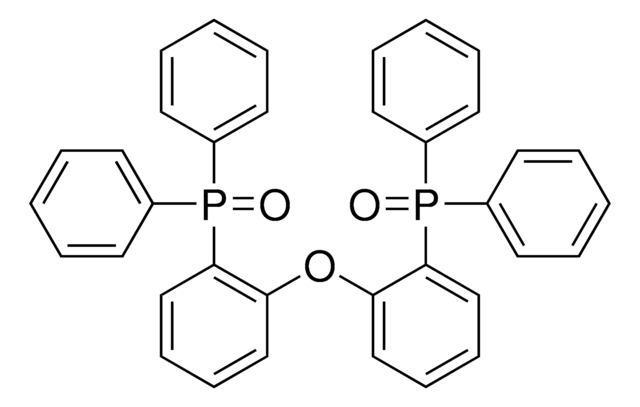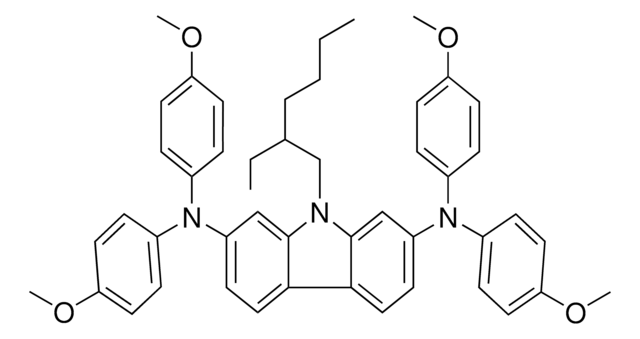推荐产品
产品名称
PO-T2T, >=99% (HPLC),
等級
sublimed grade (>99% (HPLC))
描述
PL-295, 379 nm (in CH2Cl2)
形狀
solid
分子量
Mw 909.8 g/mol
顏色
white
λmax
272 nm in dichloromethane
軌道能量
HOMO -6.8 eV
LUMO -2.8 eV
儲存溫度
15-25°C
應用
PO-T2T是有机发光二极管(OLED)中的电子传输/空穴阻挡材料,或有机电子器件中的电子受体材料。
一项在《自然》发表的研究演示了自由基OLED的有效作用,它们通过自旋双线态激子发光,而不是单线态和三线态激子。
双线态激子没有跃迁过程中的自旋禁阻问题,从而避开了长久以来的三线态激子的利用问题。采用发光自由基激子的OLED,最大外量子效率已达到27%(710nm),是目前为止已报道的深红光/近红外光发光二极管(LED)中的最高值。在这种高效的OLED器件中,采用TAPC作为空穴传输层,PO-T2T作为电子传输层,实现选择性地空穴注入HOMO,电子注入SOMO,形成近100%内量子效率的荧光双线激发态。
一项在《自然》发表的研究演示了自由基OLED的有效作用,它们通过自旋双线态激子发光,而不是单线态和三线态激子。
双线态激子没有跃迁过程中的自旋禁阻问题,从而避开了长久以来的三线态激子的利用问题。采用发光自由基激子的OLED,最大外量子效率已达到27%(710nm),是目前为止已报道的深红光/近红外光发光二极管(LED)中的最高值。在这种高效的OLED器件中,采用TAPC作为空穴传输层,PO-T2T作为电子传输层,实现选择性地空穴注入HOMO,电子注入SOMO,形成近100%内量子效率的荧光双线激发态。
装置配置:
ITO/MoO3 (3 nm)/ TAPC (35 nm)/CBP:TTM-3NCz (3.0 wt%; (40 nm)与CBP:TTM3PCz (3.0 wt%; 25 nm)/B3PYMPM (10 nm)/PO-T2T (70 nm)/LiF (0.8 nm)/Al (100 nm)。
首个基于激基复合物的串联白光有机发光二极管(WOLED)使用PO-T2T材料,设置mCP/PO-T2T和DTAF/PO-T2T两个平行混合层(parallel blend layer),分别产生蓝色和黄色的激基复合物发光。制成的器件成为首个效率优异的基于激基复合物的串联WOLED ηext:11.6%,ηc:27.7 cd/A,和ηp:15.8 ml/W,CIE(0.29, 0.35)和CRI 70.6,几乎不依赖于电致发光(EL)强度。串联构造和混合层供体/受体(1:1)配置是WOLED制造的两个要点,充分利用了激基复合物的延迟荧光,是使用丰富的低成本有机物制造商业化WOLED的典范。
ITO/MoO3 (3 nm)/ TAPC (35 nm)/CBP:TTM-3NCz (3.0 wt%; (40 nm)与CBP:TTM3PCz (3.0 wt%; 25 nm)/B3PYMPM (10 nm)/PO-T2T (70 nm)/LiF (0.8 nm)/Al (100 nm)。
首个基于激基复合物的串联白光有机发光二极管(WOLED)使用PO-T2T材料,设置mCP/PO-T2T和DTAF/PO-T2T两个平行混合层(parallel blend layer),分别产生蓝色和黄色的激基复合物发光。制成的器件成为首个效率优异的基于激基复合物的串联WOLED ηext:11.6%,ηc:27.7 cd/A,和ηp:15.8 ml/W,CIE(0.29, 0.35)和CRI 70.6,几乎不依赖于电致发光(EL)强度。串联构造和混合层供体/受体(1:1)配置是WOLED制造的两个要点,充分利用了激基复合物的延迟荧光,是使用丰富的低成本有机物制造商业化WOLED的典范。
儲存類別代碼
13 - Non Combustible Solids
水污染物質分類(WGK)
WGK 3
閃點(°F)
Not applicable
閃點(°C)
Not applicable
Tzu-Chieh Lin et al.
Nature communications, 9(1), 3111-3111 (2018-08-08)
The lack of structural information impeded the access of efficient luminescence for the exciplex type thermally activated delayed fluorescence (TADF). We report here the pump-probe Step-Scan Fourier transform infrared spectra of exciplex composed of a carbazole-based electron donor (CN-Cz2) and
Piotr Pander et al.
ACS applied materials & interfaces, 10(34), 28796-28802 (2018-07-26)
The photophysics of an exciplex state formed between a small molecule and a polymer is investigated in this work. The results obtained with this blend show the strong potential of polymer-small-molecule blends for triplet harvesting in organic light-emitting diodes (OLEDs)
Wen-Yi Hung et al.
Scientific reports, 4, 5161-5161 (2014-06-05)
Exploiting our recently developed bilayer interface methodology, together with a new wide energy-gap, low LUMO acceptor (A) and the designated donor (D) layers, we succeeded in fabricating an exciplex-based organic light-emitting diode (OLED) systematically tuned from blue to red. Further
Xin Ai et al.
Nature, 563(7732), 536-540 (2018-11-23)
Organic light-emitting diodes (OLEDs)1-5, quantum-dot-based LEDs6-10, perovskite-based LEDs11-13 and micro-LEDs14,15 have been championed to fabricate lightweight and flexible units for next-generation displays and active lighting. Although there are already some high-end commercial products based on OLEDs, costs must decrease whilst maintaining high
Yi-Tzu Hung et al.
ACS applied materials & interfaces, 10(40), 34435-34442 (2018-09-18)
Two new nonconjugated linked dicarbazole materials, dCzPSi and dCzPSO2, with high triplet energy were synthesized and characterized. dCzPSi and dCzPSO2 were adopted as unipolar host materials for the green thermally activated delayed fluorescence (TADF) emitter (4CzIPN) to achieve high-efficiency organic
商品
Professor Tokito and Professor Takeda share their new materials, device architecture design principles, and performance optimization protocols for printed and solution-processed, low-cost, highly flexible, organic electronic devices.
我们的科学家团队拥有各种研究领域经验,包括生命科学、材料科学、化学合成、色谱、分析及许多其他领域.
联系技术服务部门


![聚[双(4-苯基)(2,4,6-三甲基苯基)胺] a poly(triaryl amine) semiconductor](/deepweb/assets/sigmaaldrich/product/structures/122/933/c34a34ab-284f-4890-adb8-126247a91d9b/640/c34a34ab-284f-4890-adb8-126247a91d9b.png)





